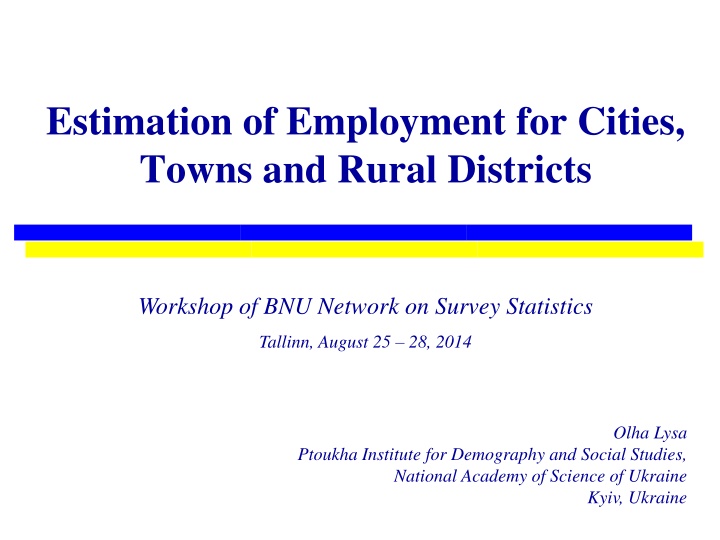
Estimation of Employment Rates in Ukraine: Survey Statistics Workshop Insights
Explore insights from the workshop on estimating employment rates in Ukrainian cities, towns, and rural districts using annual survey data. Learn about the data sources, survey methodology, challenges faced, and proposed solutions for accurate estimation.
Download Presentation

Please find below an Image/Link to download the presentation.
The content on the website is provided AS IS for your information and personal use only. It may not be sold, licensed, or shared on other websites without obtaining consent from the author. If you encounter any issues during the download, it is possible that the publisher has removed the file from their server.
You are allowed to download the files provided on this website for personal or commercial use, subject to the condition that they are used lawfully. All files are the property of their respective owners.
The content on the website is provided AS IS for your information and personal use only. It may not be sold, licensed, or shared on other websites without obtaining consent from the author.
E N D
Presentation Transcript
Estimation of Employment for Cities, Towns and Rural Districts Workshop of BNU Network on Survey Statistics Tallinn, August 25 28, 2014 Olha Lysa Ptoukha Institute for Demography and Social Studies, National Academy of Science of Ukraine Kyiv, Ukraine
Task To estimate the employment rate for cities, towns and rural districts (administrative territorial units - ATU) of Ukraine based on the annual LFS dataset
Data Sources Sample survey of households (LFS); Sample survey of enterprises (BS); Register of unemployment; Administrative data reported by enterprises ; Census data and demography statistics. o o o o o
Survey description S stratified, multistage sample design with systematic selection proportional to size; 11,1 thousand households are selected every month, representing all country; rotational scheme 3-9-3 (2/3 of sample was observed in previous month); all hh s members of age 15-70 years old are interviewed about their economical activity; complex weighting procedure: design weights, non-response adjustment, calibration to population sex-age structure S S S S
Problems Small sample size or 0 at ATU level; High variance of employment rate estimates for ATU; All rural districts are represented in the sample but not all cities and towns; High variation between estimates of employment rate in ATUs o o o o
Proposition Correction of direct estimates Microlevel modelling of probability to be employed III. Multilevel composite estimator (Longford 2010) I. II.
Cities/towns representation in sample In sample City 1 City 2 City 3 City 4 City 5 City 6 City 7 Design weight 1 1 2 3 4 6 19
I. Direct estimation 1. Sampled cities/towns Horvitz-Tompson estimator; 2. Cities/towns are not in the sample synthetic estimator (use the estimate of sampled city/town which represents them); 3. Rural districts composite estimator of urban and rural populations of district
Information Using Scheme REGIONAL LEVEL ULFS, current survey ULFS, ULFS, Auxiliary information: demography statistics previous surveys current survey LOCAL LEVEL ULFS, current survey MICROLEVEL
II. Microlevel Model Empirical probability to be employed p = 0,327+0,056 M+0,059 R+0,308 A_2+0,380 A_3+0,390 A_4+ +0,404 A_5+0,392 A_6+0,327 A_7+0,130 A_8-0,095 A_9 Fitted model 0.626 Average probability Model characteristics R2 = 0.892; F = 20.58 Factors: 1) Gender: M male; 2) Type of area: R rural; 3) Age grope: A_2 25 29 years old; A_3 30 34 years old; A_4 35 39 years old; A_5 40 44 years old; A_6 45 49 years old; A_7 50 54 years old; A_8 55 59 years old; A_9 60 69 years old. Composition between regression and direct estimates: ~ ( ) P j = + 1 P P j j jP jP jP~ composite estimate; direct estimate; modelled estimate; weighting coefficient
III. Multilevel Composite Estimator t j t j P = + + P P P , 1 , 2 3 , 1 j t j j t j t jP, t jP, tP , t jP composite estimate for ATU; composite estimate based on microlevel model for ATU; direct estimate for region what includes the estimated ATU; composite estimate for ATU from previous survey (year); 1 , , weighting coefficients 1 2 3 j j j Potential covariates: Employment rate (current) Employment rate (previous), % Level of insured workers, % Average wage, UAH. Hire employers level,% Fire employers level,% 0,940 -0,346 -0,385 0,375 0,320
Results of Simulation Direct estimate Multilevel composite estimate 80 70 60 RRMSE, % 50 40 30 20 10 0 1 2 3 4 5 6 7 8 9 10 11 12 13 14 15 16 17 18 19 20 21 22 23 24 25 Administrative Territorical Units
Conclusions Proposed approach based on multilevel composite two-stage estimation. Results of implementation in a simulation show improvement in accuracy of employment rate estimates for the cities, towns and rural districts. The RRMSE of estimates of ATUs was reduced by 45% on average. Using a microlevel model decreases variation between estimates of employment rate in ATUs We can obtain estimates for ATUs that are not in the sample.
References 1. Ghosh M., Rao J. N. K. Small Area Estimation // An Appraisal, Statistical Science. 1994. Vol. 9, 1. P. 55 93. 2. Rao J.N.K. Small Area Estimation. New York: Wiley, 2003. 314 p. 3. Longford N.T. Simulation of small-area estimators of the poverty rates in the oblasts of Ukraine. SNTL and UPF, Barcelona, Spain. The report prepared for the Social Assistance System Modernization Project, Ukraine, Kyiv, 2010.
Thank You for Attention! Olha Lysa Ptoukha Institute for Demography and Social Studies National Academy of Sciences of Ukraine Olysa@ukr.net





















